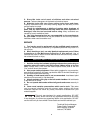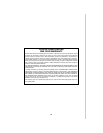
10
9
5. Work back and forth over a fairly wide area to obtain an even surface.
6. Do not let the tool tilt. The edge of the belt can make a deep cuts into the
surface.
7. Do not pause in any one spot during the sanding operation. The belt will
eat into the work and make the surface uneven.
8. Lift the tool from the work before turning the motor off.
9. Always be sure that the motor has completely stopped before putting the tool
down.
FAST SANDING ON ROUGH WORK
To smooth a rough surface quickly,
use a coarse grit abrasive belt. With
the belt positioned diagonally
across the grain, move the tool in
the direction of the grain (Fig. 5)
.
Overlap the strokes and cover the
entire surface, working from both
sides of the board (angle left and
then angle right.) Smooth the
surface by guiding the sander back
and forth with the grain. Change the
belt to a medium grit and follow the
same procedure.
Finish by thoroughly working the grain lengthwise. Change again to a fine grit
and repeat. Always finish sanding with the grain.
REMOVING OLD PAINT AND VARNISH
Read and follow “ADDITIONAL SAFETY RULES FOR
PAINT REMOVAL” section of this manual.
The 352VS is an excellent tool for removing old paint and varnish from flat
surfaces. However, two problems are common: 1) sanding material that loads
the abrasive and, 2) friction heat caused by working too long in one place. To
overcome the loading problem, use a coarse grit open coat abrasive belt and a
single stroke action. Overheating can be avoided by using a fairly quick stroke
and moving to another area quickly. A piece of felt about 1/4" thick can be
inserted under the shoe for fast spot sanding and for working on stubborn
areas of paint and varnish.
SPECIAL SANDING PROCEDURES
Generally, the operator should sand with a back and forth motion. Some
materials and some types of operations, however, require a different
technique. In rough sanding, use the tool at an angle. In spot sanding, use the
tool with only the front pulley touching the surface (especially useful in
smoothing excess glue from wood joints). On metals, slate, marble, or plastic
materials, sanding can be done in all different directions because of a lack of
grain.
Fig. 5

















